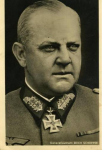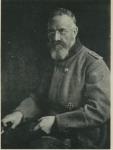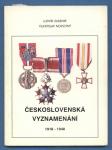-
Posts
4,908 -
Joined
-
Last visited
-
Days Won
97
Content Type
Profiles
Forums
Blogs
Gallery
Events
Store
Everything posted by Dave Danner
-
The other abbreviations were fairly normal ones for aviation units. The person in question, OLt.d.R. Nikolai Hermann Clausen, was a Hzgl. anhalt. Landmesser and Lt.d.R. in IR 162, and went to Beobachter training in 1916. I suppose artillery observer makes more sense for a Landmesser than infantry officer. I found it on p.88 of Cron: "Gruppen-Bildstelle" or "Gruppenbildstelle". Cron abbreviates it "Gru-Bi-Stelle", so I guess the Bavarians just chopped a few more letters off and smashed it together. And there was a Gruppen-Bildstelle Nr. 143, as it shows up as a unit in an awards list in the Verordnungsblatt des Kgl. Bayer. Kriegsministeriums in 1919. I am also wondering if and how he is related to Nikolai Asmus Clausen, the WW2 U-Boot commander and RKT. The name is more common than you might think. There were at least three different Nikolai Clausens in World War I, all from Schleswig-Holstein.
-

Heer Ribbon bars - ID possible?
Dave Danner replied to drspeck's topic in Wehrmacht Medals, Decorations & Awards
The shorter one is for a Saxon junior officer, possibly from Jäger-Btl. 13 or Res.-Jäger-Btl. 13. He has the enlisted man's Friedrich-August-Medaille and the officer's Albrecht-Orden, so he was probably first decorated as an officer candidate or NCO, and then again as a Leutnant. The Reuß ribbon may point to service in JB 13. Since Heinrich XXVII Fürst Reuß was à la suite Saxon Jäger-Btl. 13, officers of this battalion and its reserve battalion were among the most common Saxon recipients of Reuß decorations. But this is only a possibility. Much of Reuß ältere Linie bordered Saxony, so many Reuß citizens ended up in Saxon regiments. The larger one has a name, but perhaps you may want to wait until it arrives. Bad luck to count your chickens before they hatch. Dave -

Heer Ribbon bars - ID possible?
Dave Danner replied to drspeck's topic in Wehrmacht Medals, Decorations & Awards
Are these yours? Or is someone selling them? -
1. It looks like the Hessen General Honor Decoration for Bravery. 2. Is there a faded orange stripe in the center? That looks like it should be the Baden Silver Merit Medal on the ribbon of the Military Karl Friedrich Merit Order. 3. The second ribbon is the Saxon Friedrich August Medal in Silver. Last one is indeed the Austrian War Commemorative Medal with Swords.
-
I am pretty sure I have him, although I haven't confirmed the war decorations. The four pre-war ones are a perfect match, though, for Royal Bavarian opera singer and professor Dr. Felix von Kraus. From the 1914 Bavarian Court and State Handbook: Six decorations are listed in the entry. Four of these are on the medal bar (remember, for a Frackspange you go from upper right to lower left). The Bavarian Order of St. Michael is at #3, the Bavarian Prinzregent Luitpold Medal is at #5, the Anhalt Albert the Bear is at #6 and the Schaumburg-Lippe Arts and Sciences is at #7. As for the two decorations in the entry which are not on the medal bar, the Hessen award was the pinback cross grade of this order, and the Mecklenburg-Schwerin medal was a neck decoration. The Saxe-Meiningen and Bavarian crosses at #1 and #2 were wartime awards, and the Golden Wedding Jubilee Medal at #4 was established in 1918. Bavaria stopped gazetting the König Ludwig Cross in 1917, so I'm not sure if that can be confirmed, but it is certainly possible for someone in his position. And he received the title of Kammersänger from the Duke of Saxe-Meiningen in 1897, so even if he doesn't show up in the Meiningen rolls (there are missing names), we can confirm a Meiningen connection. So I would say this is him.
-
No LD2. A Bavarian civilian/civil servant. The SMK is non-combatant, which narrows it down considerably. How many Bavarians with that one? The real rarity is the last one, the Schaumburg Lippe Order for Arts and Sciences 1st Class. Also, he placed the SMKNK ahead of the KLK, which is not Bavarian precedence, so he may have considered himself more a Meininger than a Bavarian. Maybe a Baurat/Architekt type, since these guys often got a variety of awards depending on where they designed buildings.
-
Röhrssen was Gruppenleiter I der Wehrersatzinspektion Köslin from 27.10.39 to 31.12.43, Kdr. WBK Köslin from 1.1.43 to 28.2.43, and then Kdr. WBK Swinemünde until some time in 1944 when he went into the Führer-Reserve OKH (his file is almost illegible at that point). The signature is his file is fuzzy (the entire roll of microfilm was filmed out of focus ), but that does not appear to be it.
-

EK 1914 Some attributed EK1s
Dave Danner replied to Chris Boonzaier's topic in Germany: All Eras: The Iron Cross
Typo : Leibiger, Adolf Ludwig Hans, born 15.7.1895 in Straßburg i. Elsaß. Listed as "schwer verwundet" in Prussian casualty list Nr. 925 of 31.8.1917, presumably in the action you described here. Received the Knight's Cross 2nd Class with Swords of the Order of the Zähringen Lion on 29.7.1918. Wounded again on 7.10.1918. Best, Dave -
I would think the OLt.d.L. was too old. Possibly not the RFAR 23 officer, either, since he was artillery. Maybe the JB 13 guy, since he was a machinegunner. If he made Lt.d.R. relatively late, he might not have gotten the Albrechtorden until late 1918, if at all. There are no rolls for the Friedrich-August-Medaille.
-
I don't know about copy/replacement/private purchase vs. original issue with regard to Dutch medals, but yours is much nicer than the "original" one. That one is cast and had the cheap finish I associate with lowest bidder US medal contracts, especially in the 1990s. If someone is offering higher quality replacements for the cheap stuff governments have been contracting for, I say good on 'em and I hope the collector community keeps this in mind when labelling things as "real" or "fake". Chris mentioned French medals. I have several French National Defense Medals made by another contractor which are to me much nicer than the issue ones. The US is even worse. The DoD has been buying cheaply made medals to award to servicemembers, and at the same time has been selling as excess material much nicer versions of many of the same medals acquired under contracts between WW2 and Vietnam. This includes Silver Stars, Bronze Stars and Purple Hearts. The number of Silver Stars sold seems far in excess of the number awarded since 2001, and the ones sold include many high-quality ones contracted in the 1940s from jewelers such as Bailey, Banks and Biddle.
-
Which Saxon rolls? Award rolls? The archive in Dresden has the rolls of the Saxon Army, but was he a Saxon officer? Unless they were active Wehrmacht officers, I don't have much information on Saxon junior officers, and there I have not gotten to Wolf. The only Lt. Richard Wolf in the published Albrechtorden rolls was a field artillery officer, Lt.d.R. Richard Wolf of RFAR 23. He also received the Silver St. Henry Medal as a Vfw.d.R.. The other two were an OLt.d.L. commanding Flakzug 403, and a Feldwebelleutnant. But the published rolls are missing a lot of late-war awards. As for machinegunners, there was a Richard Wolf born in Leipzig-Möckern who was wounded in 1915 as a Reservist in the MGK/JB 13 and in 1916 as a Gefreiter in the same company.
-
That is not true. There was no requirement for another Austrian award. Nor for the Bulgarian or Hungarian awards. Some applied for all three, some for only one, some for any combination of two. For example: Oberst Helmuth Abel received the Austrian War Commemorative Medal on 24.12.1936.. Oberstlt.(W) Paul Ahlfeld received the Austrian and Hungarian commemoratives. Oberstlt. Arthur Ahrens received the Hungarian commemorative on 8.8.1939 and the Bulgarian commemorative on 11.10.1939. Oberstlt. Dr. jur. Georg Aßmann received the Austrian (20.12.1934), Hungarian (20.11.1937) and Bulgarian (14.1.1938) commemoratives. Each of these officers only received the EK2 in World War I.
-
It is the Ostmedaille. The center stripe is just blurry. Below is the Feldspange from another angle. I haven't seen a pick that doesn't show the rest of the Feldspange cleary. 1-5 are decorations: the EK2, the Ostmedaille, and the three Landesorden from WW1. #6 is the Ehrenkreuz für Frontkämpfer. 7-8 should be for the Wehrmacht Dienstauszeichnung IV-I.Klasse. #9 is probably a war commemorative medal from one of the Central Powers (Austria, Hungary or Bulgaria), as Art.Rgt. 6 was not involved in the Anschluss or Sudeten operations.
-
There is a bio (in German) which covers his service here: http://www.lexikon-der-wehrmacht.de/Personenregister/S/SchopperErich.htm His WW1 awards were the Iron Cross 1st and 2nd Class from Prussia, the Friedrich-Kreuz from the Duchy of Anhalt, the Princely Reuss Honor Cross 3rd Class with Swords, and the Ducal Saxe-Ernestine House Order Knight 2nd Class with Swords. I don't have my references handy, but I would assume the Ernestine House Order was from Saxe-Altenburg, as Schopper's field artillery regiment, FAR 74, provided fire support to Saxe-Altenburg's IR 153. They were part of the 8th Infantry Division along with, among other units, Anhalt's IR 93, which accounts for that award. Schopper was a native of Reuss.
-
Thanks Glenn! I guess that resolves that, although it raises another question. One thing that had given me pause was that he was a Hamburger, but his Hamburg Hanseatenkreuz was not in Daniel's list of non-Württemberg awards to Württembergers. Nor, for that matter, was the Hanseatenkreuz to Hermann Pinckernelle, the Landwehr Kavallerie officer from LwB Ludwigsburg. I wonder how many other awards Württemberg failed to gazette? Like Ludwig, Hermann was a Dr.jur. and Rechtsanwalt in Hamburg. Hermann went to war with a Württemberg unit, though - the 1.Landwehr-Kavallerie-Eskadron XIII. Armeekorps. He was wounded and taken prisoner on 25 September 1914 and interned in Switzerland in 1916. I did see his Friedrich Order gazetted, a WF3bX on 8 June 1917. Besides the EK2, WF3bX and HH, his family bio also lists the Austrian Red Cross Decoration with War Decoration and something listed as "Mil.Verd.Orden 3.Kl. mit Schwertern". I suppose this might be the Württemberg MVO, and the "mit Schwertern" is just an error by the family Stiftung, though if so it must have been a late or post-war retroactive one. Ah, well. Another minor mystery that may never be solved. Although maybe Hermann has a personnel file or Kriegsrangliste entry in the archives in Stuttgart...
-
Hi, Another uniform question. The officer below, Dr.jur.Ludwig Pinckernelle, was a Hptm.d.L.a.D., killed in action in 1918 as a batallion commander in LIR 75. Problem is, there were two a.D. Landwehr officers named Pinckernelle. One was a Kgl. Württemberg Landwehr-Infanterie officer. The other was a Kgl. Preußischer Garde-Landwehr-Feldartillerie officer. The Pinckernelle's were from Hamburg, which would explain how he ended up in LIR 75, but several went to university in Württemberg, and did their military service there. I know it's a pretty plain field uniform, but is there anything there - cuffs for example - which says KW infantry or KP Garde artillery?
-
EK2 - 11.9.14 EK1 - 22.3.16 HH - 21.10.16 Verw.Abz.schw. - 30.4.18 Frontk.Kz. - 4.2.35 DA IV bis I.Kl. - 2.10.36 ungar. Kriegsmed. - 19.1.38 österr. Kriegsmed. - 28.5.38 bulg. Kriegsmed. - 15.2.38 Sudeten-Med. - 1.10.38 KVK2X - 11.2.41 KVK1X - xx.11.42 (day is too blurry) For the Sudetenmedaille, that's obviously not the correct award date.
-
There are 239 entries for Liebing in the genealogy.net database of Verlustlisten, which is 78% complete. That's killed, wounded or missing, and of course the same person can appear multiple times. It appears from the birthplaces that at least half of these are Saxons (and many of the others are from Thuringia or Prussian Saxony). There are IR 106 and RIR 106 histories in the Erinnerungsblätter series. I have no idea if they have Ehrentafeln.
-
Is that a thing? I have an entry for an Ehrenwaffe to a Jägeroffizier, but his handwriting is hard to read. I don't have the original (still in the archives) so I just copied the handwriting as best I could. I tried deciphering it and looking for something that matched, and this was the best I could come up with. I take it from dict.cc that a Hirschfänger, or "Deer catcher", is a specific type of hunting knife. Is this something traditionally associated with Jäger battalions? In this officer's case, the Garde-Jäger-Bataillon? I've come across a number of entries for Ehrenwaffen, but they are mostly the expected ones: Ehrendegen, Ehrendolch, Ehrensäbel, Ehrenseitengewehr. What others are there? Thanks, Dave
-

Czechoslovakia Czechoslovak ODM
Dave Danner replied to bilylev's topic in Central & Eastern European States
Hi Jan, Nice examples, especially with the devices. There is at least one book, but it is only a small paperback, and it is mainly a price guide, but at least it has pictures. I do not know where it might be available. Československá vyznamenání 1918-1948, by Ludvík Sukeník and Vlastislav Novotný, published in 1997. Here are the cover and two sample pages: http://gmic.co.uk/uploads/monthly_02_2014/post-432-0-07530600-1392068768.jpghttp://gmic.co.uk/uploads/monthly_02_2014/post-432-0-95485500-1392068775.jpghttp://gmic.co.uk/uploads/monthly_02_2014/post-432-0-71140100-1392068784.jpg Regards, Dave










